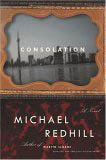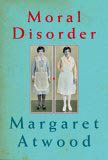
Consolation
$32.95 hardcover

Moral Disorder
$32.99 hardcover
September 2006
Two novels not to be confused
Tip for readers this month: don't take on both of the new books by Michael Redhill and Margaret Atwood at the same time. As I did.
Although the storylines are quite different, the two works have enough parallels in the characters and the writing to thoroughly confuse someone trying to juggle both in the imagination. I finally had to drop the Redhill to concentrate on the Atwood and then wait a few days after finishing that one to get back into the Redhill. I think I have the characters straight now.
The process was interesting though because it showed me how much better as a novel Redhill—s Consolation is than Atwood's Moral Disorder—despite other early reviews that would have indicated the contrary.
Yes, I realize Moral Disorder is supposed to be a series of connected short stories rather than as a novel, somewhat like Alice Munroe's justly celebrated Lives of Girls and Women. But few of the "stories" or chapters in Atwood's attempt really provide the emotional punch or closure expected in the short narrative form.
Taking them both as novels then, the similarities between Consolation and Moral Disorder run deeper than both having abstract titles. Each focuses on family relationships, each involving two sisters, a deceased father who had been involved in research, and a widowed mother in pain. The dynamics are quite similar in places.
But, frankly, after finishing both novels I cannot tell you how those relationships worked out in Atwood's book. Even while reading it exclusively, I had difficulty keeping any significant details in mind. Perhaps because there aren't any. Or rather they aren't presented in any dramatic fashion or with a story that impresses itself upon the mind.
A lot of dialogue on nothing much in particular, a lot of interior agonizing over the same—not even much of Atwood's trademark irony to liven it up. The whole exercise strikes me more as notes for characters or for a background situation to appear in a story or novel, not a story or novel in itself.
Time is fluid in this collection. The first chapter or story seems to start in the present or perhaps the near future but the next sections take us back to the 1940s, introducing the characters again and then following them back up to the present. The best episode is perhaps the final one when the daughter recalls the past once more, this time through her failing mother's eyes—viewing the years the family spent with the father and a small research team studying insects in Northern Labrador. But even this is really a slice-of-mental-life rather than a story to remember.
Redhill's Consolation on the other hand presents a truly fascinating story involving the family—fascinating especially for anyone interested in Toronto history. The father, a professor, had drowned himself in the harbour, suffering from ALS (Lou Gehrig's disease) and dismissed by the academic community for presenting an unsubstantiated theory about the early history of Toronto: he believed that a boat containing a photographic record of the city 150 years ago had sunk in the harbour during the fierce storm that separated the Toronto Islands from the mainland and that the boat was subsequently buried under earth and rubble when the city's shoreline was extended outwards by hundreds of yards.
After his death, his widow watches the foundations being dug for the Air Canada Centre—exactly where the boat should be if his theory is right. One of her sons-in-law, who had believed in her husband more than she did, forms a strange alliance and rivalry with her as they await the professor's vindication.
Meanwhile we also follow a story from 1856 involving the struggle of an apothecary-turned-photographer to survive in Toronto. An incredible picture of the primitive city is painted in this narrative thread that we expect will also lead to the truth about the purported boat and photographs. (Running parallel tales between the present and the historical past seems to be a trend in Canadian novels these days.)
Redhill, like Atwood, is also a noted poet and his prose is often criticized for featuring too many poetic flourishes. The criticism is justified in Consolation as occasionally we get colourful images and metaphors that don't plausibly come from the current character's point of view, and sometimes the author gets too involved in relating details we don't need. But he doesn't go overboard with this as some of Canada's more precious poet-novelists do, and his story and characters are strong enough to hold the interest past the occasional too-clever patch.
Redhill is also an accomplished playwright, as seen recently in the politically and emotionally charged Goodness that has enthralled Toronto and international audiences over the past year. He brings to his Consolation a dramatic sensibility that most poets lack.
To be read and enjoyed by itself.
— Eric McMillan



